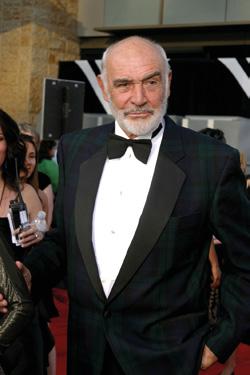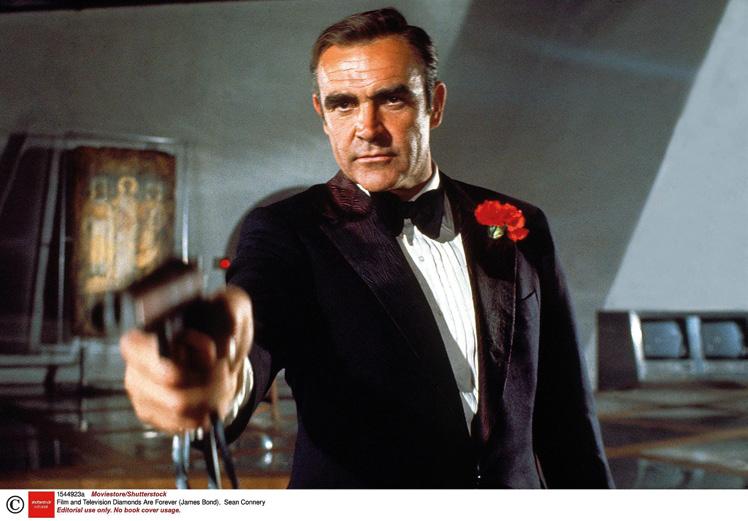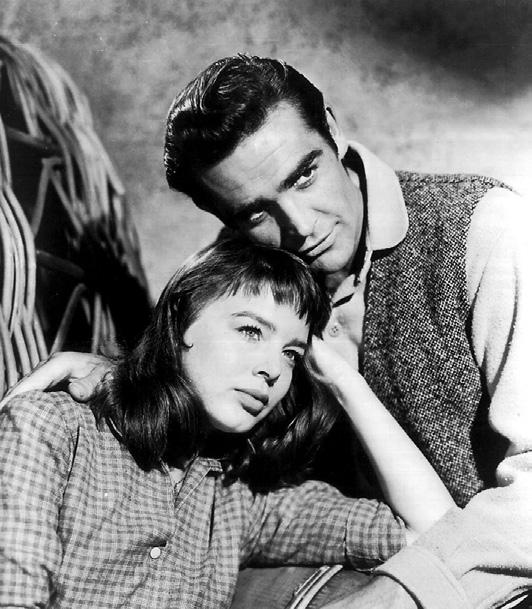
11 minute read
007 hits 90
Age no handicap as Sean Connery plays his way to 100

On the occasion of Sean Connery’s 90th birthday, Aubrey Malone spotlights the life - so far! - and extraordinary times of our favourite James Bond
The Name is Connery, Sean Connery
‘Sir’ Sean is 90. Shaken but not stirred by the milestone, cinema’s best 007 by a mile celebrated it in the Bahamas with Micheline Roquebrune, his Moroccan-born artist wife of 45 years.
He lives with her in the exclusive part of New Providence Island. Nearby is a beach, a marina and a golf course. A house without a golf course nearby is, to Connery, like a house without bricks. Films were always a sideline to getting his handicap down. Didn’t he once say, ‘I go from being Arnold Palmer to Lilli Palmer’?
He was born Thomas Sean Connery in 1930 in a small flat in Edinburgh. There was no hot water and no bathroom. The communal lavatory was outside. For years he had only gas lighting.The Thomas and Sean came from his Irish grandfather. The street was called ‘the street of a thousand smells’ because of all the factories in the area. His father worked in one of them. His mother was a cleaning woman. ‘I didn’t know I lacked anything,’ he said, ‘because I had nothing to compare it with.’
Connery fought his way out of the poverty trap by doing everything he could – milkman, lorry driver, lifeguard, coffin polisher, artist’s model. He started a regime of body-building in the fifties and entered a Mr Universe competition in 1953, coming a very respectable third. He even had a try-out for Manchester United. Matt Busby thought he had potential on the field. Connery said no because a footballer’s career was too short. ‘He could be retired at 30,’ he claimed.
He had a respectable stage career that’s often overlooked in biographies of him. Shakespeare was a paragon for him. He did a creditable Macbeth once. Ibsen and Pirandello were other heroes. He was also a fan of our own James Joyce.
He played some forgettable screen villains before being chosen by Lana Turner to appear opposite her in the 1958 feature AnotherTime, Another Place. In between scenes he had a set-to with her gangster boyfriend, Johnny Stompanato.
Stompanato thought they were having an affair. He visited the set one day and waved a gun in Connery’s face, telling him to stay away from Turner. Unperturbed, the fiery Scot flattened him with a right to the nose.
He was advised to lie low for a while. Stompanato knew some Very Bad People. Lana’s daughter Cheryl would subsequently stab him to death after he beat Lana up. There was a rumour it was Lana herself who did it, letting Cheryl take the rap.
Sean Connery with Micheline Roquebrune, his Moroccan-born artist wife of 45 years.
Not many stars have colourful back stories like this. For most people, Connery began with Bond.
Ian Fleming, his creator, wasn’t in favour of him playing him at first. ‘I’m looking for Commander James Bond,’ he said, ‘not an overgrown stunt man.’ Connery was 6ft 2in.
Fleming thought he looked more like a bricklayer than the champagne-and-caviar hero he was supposed to be playing - and more likely to be swilling pints than Dom Perignon ’57.
He also thought his accent would come against him. He spoke like his mouth was full of marbles. How was he going to play the role – in a kilt? He later amended that view, even giving Bond a Scottish father in You Only Live Twice. Connery’s view of Fleming was that he was ‘a terrible snob but great company.’
In Dr No, his first outing as the refined spy, he shared the screen with Ursula Andress. She emerged from the sea in ‘that’ bikini. Her surname was amended to ‘Undress.’ Some viewers thought her shoulders were as big as Connery’s.
The film became a sensation, going all around the world. It made $6 million in America alone. In Japan it was translated as ‘No Need For Doctors.’

In familiar pose as agent 007
He played some forgettable screen villains before being chosen by Lana Turner to appear opposite her in the critically successful 1958 feature Another Time, Another Place. wanted. From what I could tell, he did.’ it. I still go around the house turning off all the unused Only Live Twice.


With Janet Munro in the 1959 ‘Oirish’ comic melodrama Darby O’Gill and the little people
Keeler, Julie Christie. Angry Young Men had gone for their tea. The spy to talk about. Juvenile or not, he’d liberated Britain from the grey fifties. had come in from the cold. He said You Only Live Twice was ‘positively my last appearance’ as Bond became a brand. Men wanted to be him and would he don the smart suits and the toupees, no women wanted to bed him. ‘At the height of his fame,’ longer mouth the silly one-liners as he sent villains to Diana Dors opined, ‘He could have had any woman he their happy hunting grounds. Bond in 1967. ‘Never again,’ he snarled. No longer He always professed to hate 007. ‘I’d love to kill him,’ He was an aspirational figure for full-blooded men who he said once. The role was ‘a cross, a privilege, a joke, drove fast cars and dated fast women. The gadgets a challenge – and as bloody intrusive as a nightmare.’ were impressive too, if juvenile. Boys with toys. He told an interviewer who identified him with it: ‘The Connery had more money than he knew what to do functioning reasonably well before Bond, and that one with. The factory worker’s son said, ‘I’m not used to With ex-wife Diane Cilento is going to function reasonably well after Bond.’ lights.’ The performances he preferred were those where he He married Diane Cilento in 1962. The films came thick and fast as the contrived gadgets at demented villains trying to take over the world. He sixties progressed. From Russia with Love, Goldfinger, Thunderball, You was wonderful in many of them – The Hill, The Molly Maguires, Zardoz. important thing to get across is the fact that one was didn’t have to go to bed with women who were trying to kill him or flash But of course everyone primarily associated him with 007. No matter In between he did ‘important’ work. With each outing he said he was be- how many Bonds came after him, he was the barometer. Roger Moore coming more and more fed up of Bond. But it was Bond people wanted admitted, ‘Sean’s the real Bond. People think I’m his stand-in.’ Moore may

With Michael Caine and director John Huston on the set of The Man Born To Be King
have had the urbanity but Connery had the wit. ‘Roger comes in the humour door,’ Connery said, ‘I go out it.’
Off-screen he wasn’t too humorous at all. ‘I’m a Celt,’ he said, ‘I’m moody.’ He refused to go around with a ‘Welcome’ mat around his head. If people didn’t like him, that was their problem.
The marriage with Cilento rumbled on throughout the decade. They were a glamorous couple, living off his astronomical earnings. He was sometimes tagged with being tight with money. It wasn’t a subject he enjoyed talking about. In 1965 he’d said, ‘I never ask anybody what they earn and I don’t tell anybody what I earn. I want all I can get. I’m entitled to it. I don’t believe all that stuff about starving in a garret or being satisfied with artistic appreciation only.’
Whatever sentimentality he had seemed to be reserved for the country of his birth. He had matching tattoos that said, ‘Scotland Forever’ and ‘Mum and Dad.’
He was back as Bond in Diamonds Are Forever in 1971. Never again? Think again, Sean. The money was hard to resist.
Cilento divorced him two years later. He had to give her a large slice of his fortune in their settlement. She deserved it. She’d helped him enormously when he was trying to find the best way into Bond. He liked to talk about a group of men in Hollywood who belonged to a group called Divorce Anonymous: ‘It works like this. If a member of the group starts to feel the urge to end their marriage, they send over an accountant to talk him out of it.’
Cilento said she left him ‘after he bashed my face in with his fists.’ It was a startling quotation that stopped people in their tracks.
They started to join the dots about his temper. An interviewer had once asked him how he felt about the fact that Bond roughed up women. His reply was astounding: ‘I don’t think there’s anything particularly wrong with hitting a woman although I don’t recommend doing it the same way that you’d hit a man. An open-handed slap is justified if all other alternatives fail and there’s been plenty of warning.’ Was he from the Stone Age?
Things got weirder when he said, ‘One of the appeals Bond has for women is that he’s decisive. By their nature women aren’t. “Shall I wear this? Shall I wear that?” Then along comes a man who’s absolutely sure of everything and he’s a godsend.’ He didn’t add, ‘Especially if he administers the open-handed slap.’ But you felt he might have.
The comments haunted him over the next few decades. How did he survive them? Only Connery could have. If remarks like that were associated with an actor today it would no doubt spell the end of his career. His talent helped him survive. People talk about the many blockbuster films he made but there are also many unheralded ones like Sidney Lumet’s downbeat thriller The Offence in 1973. It was rumoured to have been inspired by the death of his father, a man who had a huge influence
Sean Connery at 90 and reputed to be worth £100 million

on him. He projected his grief onto the role of a near-psychotic police officer in the role. The film died at the box office but he didn’t mind. When people were queuing around corners to see him as Bond it was almost a novelty to make a film nobody went to.
‘Artistic appreciation’ also fed into other roles he made when he wasn’t being Bond, like The Man Who Would Be King (1975) with his good friend Michael Caine, and Robin and Marian (1976). ‘It was supposed to be called The Death of Robin Hood,’ he said, ‘but Americans don’t like heroes who die.’
By now he was married to Micheline. He’d met her as far back as 1969 when things were going badly with Cilento. She was a year older than him and equally passionate about golf. More importantly, she had little or no interest in movies. She said she fell in love with him at first sight but both of them were married to other people at the time.
Connery made a comeback as Bond in Never Say Never Again in 1983. The title was suggested by Micheline. She thought it would be fun considering his promise never to don the famous tux again. It was. More importantly, it made him a fortune. Again.
An Oscar followed two years later for a supporting role in Brian De Palma’s The Untouchables. There were those who thought he’d never come within an asses’ roar of Hollywood’s greatest accolade. Those who associated him more with Darby O’Gill and the Little People than Macbeth had to think again.
The following years threw up some strange role choices. In Indiana Jones and the Last Crusade (1989) he played Harrison Ford’s father despite being only twelve years older than him. In Family Business in the same year he was Dustin Hoffman’s father despite being only seven years his senior.
He was entitled to feel hard done by. Was he seen as being older because he was going thin on top? Barbara Carrera, who played Fatima Blush in Never Say Never Again, told him he looked better without a wig. Kevin Costner asked him to do a cameo in Robin Hood: Prince of Thieves in 1991. He was given $500,000 for just five lines of dialogue and a single day’s work. He donated the money to some worthy causes he was affiliated with. People accused him of making the donations as a tax dodge. He exploded in anger. Would he ever outgrow the image of the tight-fisted Scot?
He was voted The Sexiest Man Alive in 1999. His reaction was classic Bond: ‘Are there sexy dead ones?’
In 2006, the year of his retirement, he received the American Film Institute’s Life Achievement Award. In his acceptance speech he said, ‘Making movies is either Utopia or shovelling s**t uphill. Tonight I propose we put down our shovels and remember the good times. ‘










